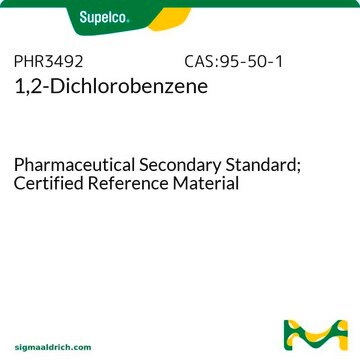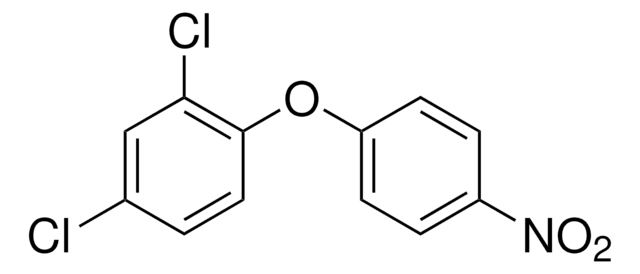36707
1,2-Dichlorobenzene
PESTANAL®, analytical standard
About This Item
Productos recomendados
grade
analytical standard
Quality Level
vapor density
5.1 (vs air)
vapor pressure
1.2 mmHg ( 20 °C)
1.6 mmHg ( 35 °C)
product line
PESTANAL®
autoignition temp.
1198 °F
shelf life
limited shelf life, expiry date on the label
expl. lim.
9.2 %
technique(s)
HPLC: suitable
gas chromatography (GC): suitable
refractive index
n20/D 1.551 (lit.)
bp
178-180 °C (lit.)
mp
−18-−17 °C (lit.)
density
1.306 g/mL at 25 °C (lit.)
application(s)
agriculture
environmental
format
neat
SMILES string
Clc1ccccc1Cl
InChI
1S/C6H4Cl2/c7-5-3-1-2-4-6(5)8/h1-4H
InChI key
RFFLAFLAYFXFSW-UHFFFAOYSA-N
¿Está buscando productos similares? Visita Guía de comparación de productos
Categorías relacionadas
Application
Legal Information
signalword
Warning
Hazard Classifications
Acute Tox. 4 Inhalation - Acute Tox. 4 Oral - Aquatic Acute 1 - Aquatic Chronic 1 - Eye Irrit. 2 - Skin Irrit. 2 - Skin Sens. 1B - STOT SE 3
target_organs
Respiratory system
Storage Class
6.1C - Combustible acute toxic Cat.3 / toxic compounds or compounds which causing chronic effects
wgk_germany
WGK 2
flash_point_f
150.8 °F - closed cup
flash_point_c
66.0 °C - closed cup
ppe
Eyeshields, Faceshields, Gloves, type ABEK (EN14387) respirator filter
Choose from one of the most recent versions:
¿Ya tiene este producto?
Encuentre la documentación para los productos que ha comprado recientemente en la Biblioteca de documentos.
Los clientes también vieron
Nuestro equipo de científicos tiene experiencia en todas las áreas de investigación: Ciencias de la vida, Ciencia de los materiales, Síntesis química, Cromatografía, Analítica y muchas otras.
Póngase en contacto con el Servicio técnico









